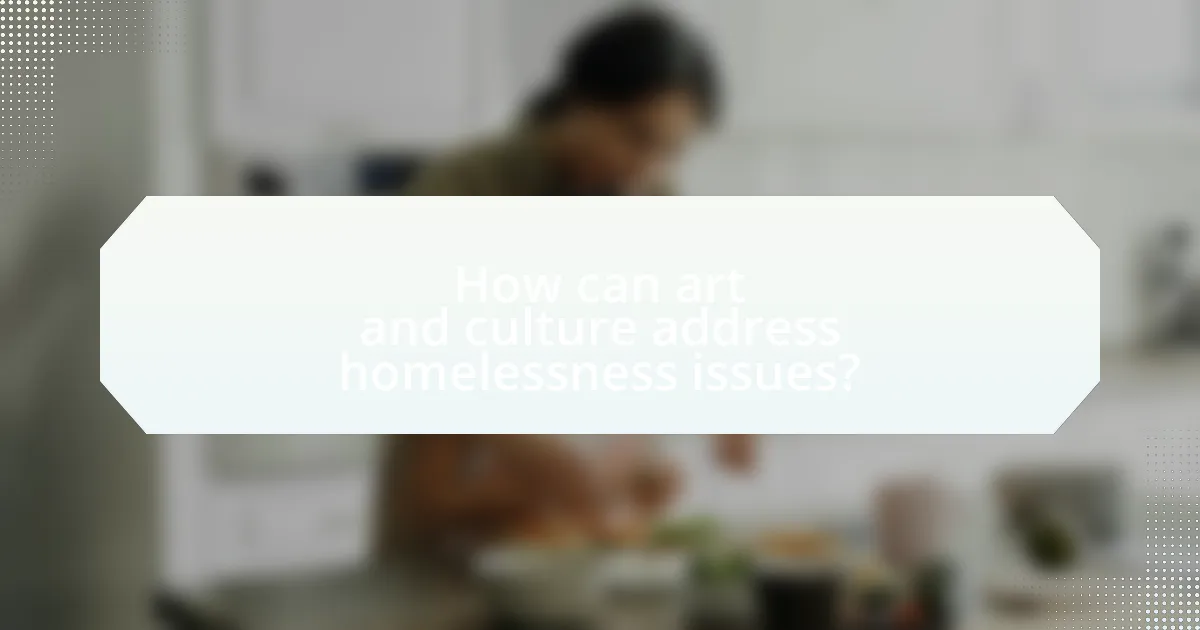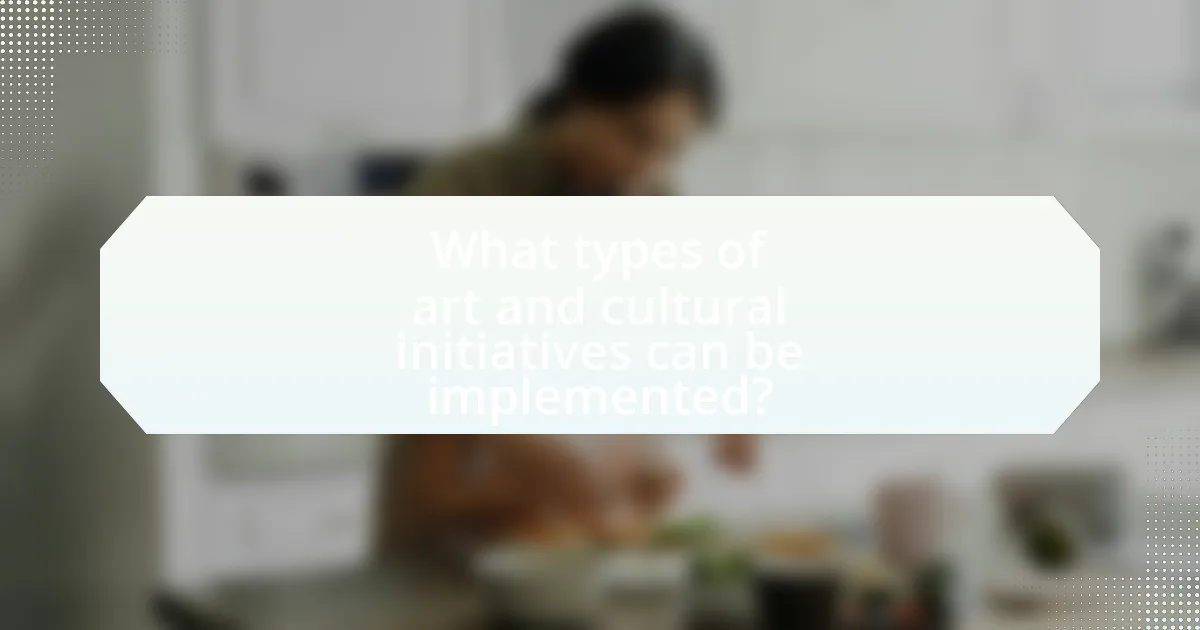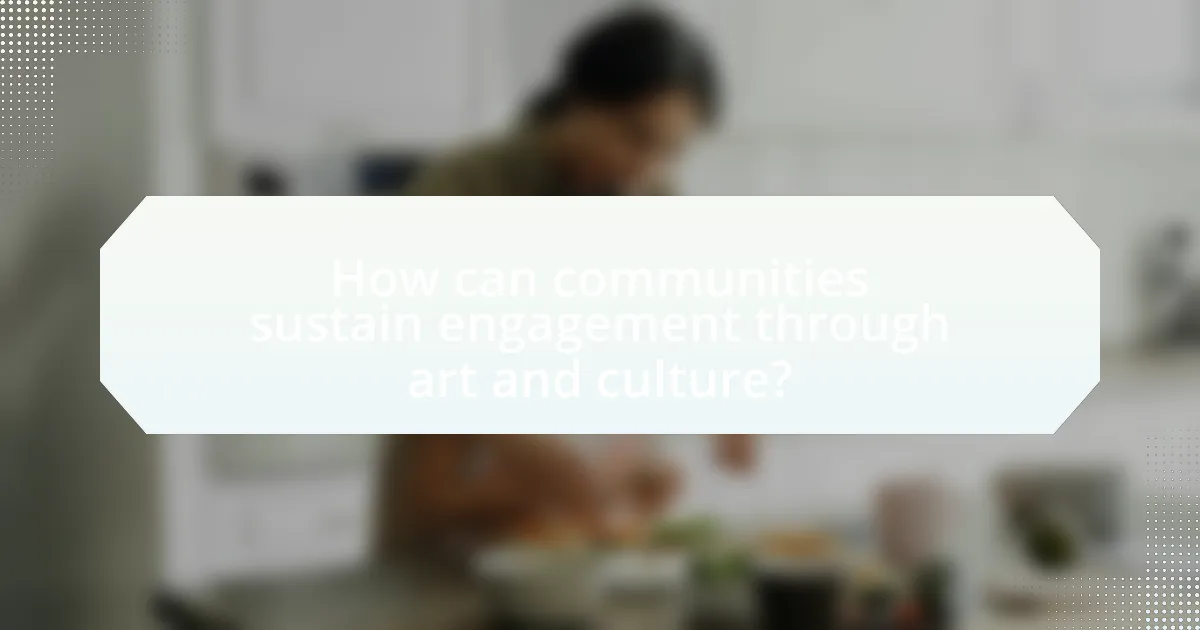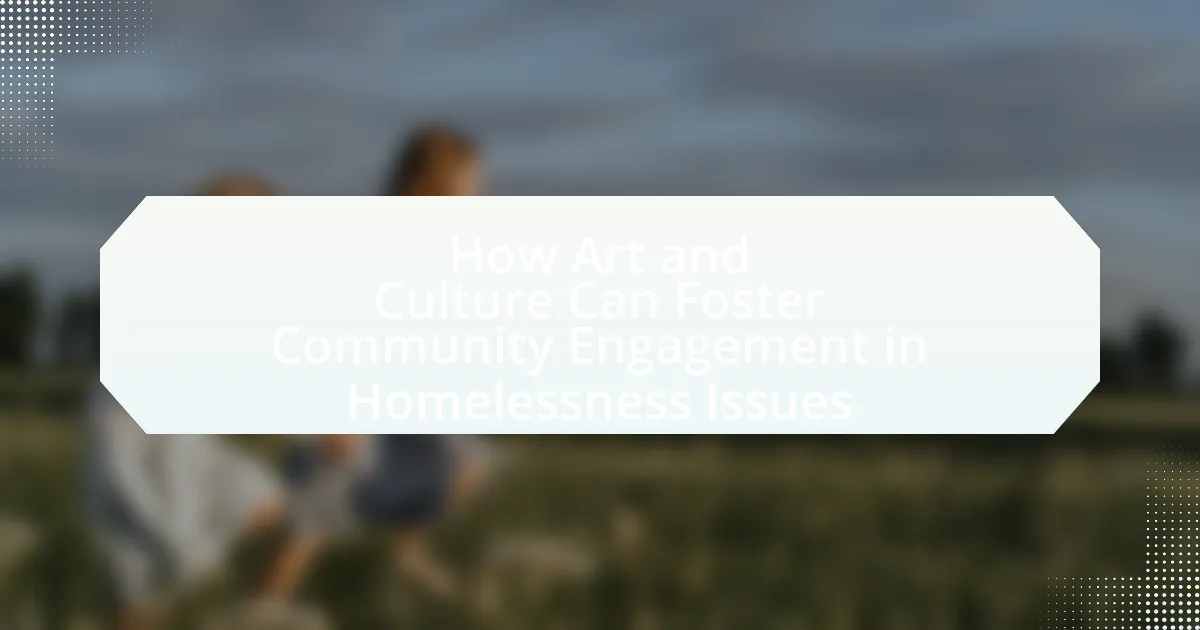The article examines how art and culture can effectively address homelessness issues by fostering community engagement and awareness. It highlights various creative initiatives, such as public art projects, theater performances, and community workshops, that humanize the experiences of homeless individuals and encourage dialogue among community members. The role of community engagement is emphasized as crucial for identifying needs and mobilizing resources, with evidence showing that collaborative efforts lead to more effective solutions. Additionally, the article discusses the psychological benefits of community involvement for both the homeless and the broader community, as well as best practices for sustaining engagement through art and culture.

How can art and culture address homelessness issues?
Art and culture can address homelessness issues by fostering awareness, empathy, and community engagement. Creative initiatives, such as public art projects and performances, can highlight the experiences of homeless individuals, encouraging dialogue and understanding among community members. For instance, the “Homeless World Cup” uses soccer to unite homeless individuals and raise awareness about their challenges, demonstrating how sports and art can create a platform for social change. Additionally, art therapy programs have been shown to improve mental health and well-being among homeless populations, providing them with a means of expression and healing. These approaches not only humanize the issue but also mobilize community resources and support for effective solutions.
What role does community engagement play in addressing homelessness?
Community engagement plays a crucial role in addressing homelessness by fostering collaboration between local organizations, government, and individuals to create effective solutions. Engaged communities can identify specific needs, mobilize resources, and implement programs that directly support homeless individuals. For instance, studies show that cities with strong community involvement in homelessness initiatives, such as participatory budgeting and local outreach programs, have seen a reduction in homelessness rates. This collaborative approach not only enhances the effectiveness of services but also builds social cohesion, empowering residents to take an active role in addressing the issue.
How can art initiatives foster community involvement in homelessness issues?
Art initiatives can foster community involvement in homelessness issues by creating platforms for dialogue and awareness. These initiatives often engage local artists and community members to collaborate on projects that highlight the experiences of homeless individuals, thereby humanizing their struggles and encouraging empathy. For instance, public art installations or community murals can serve as visual narratives that spark conversations about homelessness, leading to increased community engagement and support for local services. Research shows that art can effectively mobilize communities; a study by the National Endowment for the Arts found that arts-based interventions can enhance social cohesion and community participation, which are crucial for addressing complex social issues like homelessness.
What cultural activities can raise awareness about homelessness?
Cultural activities that can raise awareness about homelessness include art exhibitions, theater performances, and community workshops focused on the experiences of homeless individuals. Art exhibitions featuring works created by or about homeless people can provide a visual narrative that humanizes their struggles, fostering empathy among viewers. Theater performances that depict stories of homelessness can engage audiences emotionally, prompting discussions about societal responsibilities. Community workshops that involve homeless individuals sharing their stories can create direct connections between them and the public, enhancing understanding and compassion. These activities have been shown to effectively engage communities and stimulate conversations about homelessness, as evidenced by initiatives like the “Homeless World Cup,” which uses sports and art to raise awareness and promote social inclusion.
Why is it important to involve the community in homelessness solutions?
Involving the community in homelessness solutions is crucial because it fosters collaboration, enhances resource allocation, and ensures that interventions are tailored to the specific needs of those affected. Community involvement leads to a more comprehensive understanding of local issues, as residents often have firsthand knowledge of the challenges faced by homeless individuals. Research indicates that programs designed with community input are more effective; for instance, a study by the National Alliance to End Homelessness found that community-driven initiatives resulted in a 30% increase in successful housing placements. Engaging the community not only builds trust but also mobilizes local resources, creating a sustainable support network for homeless individuals.
How does community involvement impact the effectiveness of homelessness programs?
Community involvement significantly enhances the effectiveness of homelessness programs by fostering collaboration, resource sharing, and tailored solutions. When local residents participate in these programs, they contribute valuable insights into the specific needs and challenges faced by the homeless population, leading to more effective interventions. Research indicates that programs with strong community engagement report higher success rates; for instance, a study by the National Alliance to End Homelessness found that communities with active volunteer networks and local partnerships saw a 30% reduction in homelessness over five years. This demonstrates that community involvement not only mobilizes resources but also creates a supportive environment that encourages sustainable change.
What are the psychological benefits of community engagement for both the homeless and the community?
Community engagement provides significant psychological benefits for both the homeless and the broader community by fostering a sense of belonging and reducing stigma. For the homeless, participation in community activities can enhance self-esteem and provide social support, which are crucial for mental well-being. Research indicates that social inclusion can lead to improved mental health outcomes, as individuals feel valued and connected to others.
For the community, engaging with homeless individuals can promote empathy and understanding, reducing prejudices and fostering a more inclusive environment. Studies show that communities that actively engage with marginalized groups experience lower levels of social isolation and increased community cohesion. This mutual interaction not only benefits individual mental health but also strengthens community ties, creating a more supportive and resilient society.

What types of art and cultural initiatives can be implemented?
Art and cultural initiatives that can be implemented include community art projects, public murals, theater performances, and art exhibitions focused on homelessness. Community art projects engage local artists and residents to create works that reflect their experiences and challenges, fostering dialogue and understanding. Public murals can beautify neighborhoods while raising awareness about homelessness, as seen in cities like Philadelphia, where murals tell stories of local residents. Theater performances can dramatize the experiences of homeless individuals, encouraging empathy and community involvement, as demonstrated by organizations like The Actors’ Gang in Los Angeles. Art exhibitions can showcase works by homeless artists, providing them with a platform and promoting social change, similar to initiatives by organizations like ArtLifting, which supports artists from marginalized communities. These initiatives not only enhance community engagement but also contribute to a broader understanding of homelessness issues.
How can visual arts contribute to community engagement in homelessness issues?
Visual arts can significantly contribute to community engagement in homelessness issues by fostering awareness and empathy among the public. Art initiatives, such as murals or exhibitions featuring the experiences of homeless individuals, can humanize their struggles and encourage community dialogue. For instance, the “Homeless Art Project” in San Francisco has successfully showcased the stories of homeless artists, leading to increased public understanding and support for homelessness solutions. This approach not only raises awareness but also invites community members to participate in discussions and actions aimed at addressing homelessness, thereby creating a more inclusive environment.
What are some successful examples of mural projects addressing homelessness?
Successful examples of mural projects addressing homelessness include the “Homelessness is Not a Crime” mural in San Francisco and the “Wall of Hope” in Los Angeles. The San Francisco mural, created by local artists, depicts the struggles and humanity of homeless individuals, raising awareness and fostering empathy within the community. The “Wall of Hope” in Los Angeles features artwork by homeless artists, providing them a platform to express their experiences and connect with the public. These projects not only beautify urban spaces but also serve as powerful tools for dialogue and community engagement regarding homelessness.
How can photography be used to tell the stories of homeless individuals?
Photography can be used to tell the stories of homeless individuals by capturing their lived experiences and emotions, thereby humanizing their struggles. Through visual storytelling, photographers can convey the realities of homelessness, showcasing not only the challenges faced but also the resilience and dignity of individuals. For instance, projects like “The Homeless Project” by photographer Lee Jeffries highlight the personal narratives of homeless people, creating a deeper understanding among viewers. This approach fosters empathy and encourages community engagement by prompting discussions about homelessness and inspiring action to address the issue.
What role do performing arts play in raising awareness about homelessness?
Performing arts play a crucial role in raising awareness about homelessness by providing a platform for storytelling that humanizes the experiences of individuals affected by this issue. Through theater, dance, and music, artists can convey the emotional and social complexities of homelessness, fostering empathy and understanding among audiences. For instance, productions like “The Homeless Project” have successfully highlighted personal narratives, prompting community discussions and encouraging action. Research indicates that engaging with the arts can lead to increased awareness and advocacy, as seen in studies showing that audiences exposed to performances about social issues are more likely to support related initiatives.
How can theater productions highlight the challenges faced by the homeless?
Theater productions can highlight the challenges faced by the homeless by portraying their stories through authentic narratives and character development. By using real-life experiences and testimonials, productions can create relatable characters that reflect the struggles of homelessness, such as lack of shelter, mental health issues, and societal stigma. For instance, plays like “The Homeless Chronicles” have successfully depicted the daily realities of homeless individuals, raising awareness and empathy among audiences. This approach not only educates the public but also fosters dialogue about homelessness, encouraging community engagement and potential solutions.
What impact do music festivals have on community perceptions of homelessness?
Music festivals can significantly alter community perceptions of homelessness by fostering empathy and awareness among attendees. These events often highlight social issues, including homelessness, through art, music, and community engagement initiatives. For instance, festivals may include fundraising efforts for local shelters or feature speakers who share personal stories about homelessness, which can humanize the issue and encourage community support. Research indicates that exposure to diverse narratives at such events can lead to increased understanding and compassion towards marginalized groups, thereby shifting public attitudes.

How can communities sustain engagement through art and culture?
Communities can sustain engagement through art and culture by creating inclusive programs that encourage participation and collaboration among diverse groups. These programs can include community art projects, cultural festivals, and workshops that invite local artists and residents to contribute their perspectives and talents. For instance, research from the National Endowment for the Arts indicates that community-based art initiatives can enhance social cohesion and foster a sense of belonging, which is crucial for addressing issues like homelessness. By actively involving community members in the creative process, these initiatives not only promote artistic expression but also build relationships and networks that support ongoing engagement and advocacy for social issues.
What strategies can be employed to maintain ongoing community involvement?
To maintain ongoing community involvement, organizations can implement regular engagement activities such as workshops, art exhibitions, and cultural events that directly involve community members. These activities foster a sense of ownership and belonging, encouraging participants to contribute their ideas and talents. Research indicates that communities engaged in cultural activities report higher levels of social cohesion and participation, as seen in studies by the National Endowment for the Arts, which highlight the positive impact of arts on community engagement. By consistently providing platforms for expression and collaboration, organizations can sustain interest and involvement over time.
How can partnerships with local organizations enhance sustainability?
Partnerships with local organizations enhance sustainability by leveraging community resources and expertise to address environmental and social challenges effectively. These collaborations can lead to the development of localized solutions that are culturally relevant and economically viable, fostering a sense of ownership among community members. For instance, a study by the National Endowment for the Arts found that community-based art initiatives not only improve local engagement but also promote sustainable practices by integrating cultural values into environmental stewardship. This synergy between local organizations and sustainability efforts creates a more resilient community capable of addressing homelessness and other pressing issues through innovative, culturally-informed approaches.
What funding opportunities exist for art and culture initiatives focused on homelessness?
Funding opportunities for art and culture initiatives focused on homelessness include grants from organizations such as the National Endowment for the Arts, which supports projects that address social issues through creative expression. Additionally, local arts councils often provide funding specifically for community-based projects that engage marginalized populations, including those experiencing homelessness. For example, the ArtPlace America initiative funds creative placemaking projects that integrate arts and culture into community development, with a focus on improving the lives of vulnerable populations. These funding sources are designed to empower artists and organizations to create impactful work that raises awareness and fosters community engagement around homelessness.
What best practices can communities adopt for effective engagement?
Communities can adopt several best practices for effective engagement, including fostering inclusive dialogue, utilizing art as a medium for expression, and building partnerships with local organizations. Inclusive dialogue ensures that diverse voices are heard, which enhances community trust and participation. Utilizing art, such as murals or performances, can create emotional connections and raise awareness about homelessness issues, as evidenced by initiatives like the “Art for Change” program, which successfully engaged local artists to address social issues. Building partnerships with local organizations, such as shelters and advocacy groups, can provide resources and support, facilitating a more comprehensive approach to community engagement. These practices collectively enhance the effectiveness of community efforts in addressing homelessness.
How can feedback from the homeless community shape future initiatives?
Feedback from the homeless community can significantly shape future initiatives by providing firsthand insights into their needs and experiences. Engaging with this community allows organizations to tailor programs that address specific challenges, such as access to healthcare, housing stability, and employment opportunities. For instance, a study by the National Alliance to End Homelessness found that initiatives designed with direct input from homeless individuals are more effective in meeting their needs, leading to higher rates of successful outcomes. By incorporating this feedback, future initiatives can be more responsive and impactful, ultimately fostering a more inclusive approach to addressing homelessness.
What are the key elements of a successful community art project addressing homelessness?
Key elements of a successful community art project addressing homelessness include collaboration with homeless individuals, community engagement, and a focus on storytelling. Collaboration ensures that the voices of those experiencing homelessness are included, fostering authenticity and relevance in the art created. Community engagement involves involving local residents and stakeholders in the planning and execution of the project, which builds support and awareness. A focus on storytelling allows the project to humanize the experiences of homeless individuals, creating empathy and understanding among the broader community. These elements are supported by studies showing that participatory art projects can lead to increased community cohesion and awareness of social issues, such as homelessness.
What are the challenges faced in using art and culture for community engagement?
The challenges faced in using art and culture for community engagement include accessibility, funding limitations, and cultural sensitivity. Accessibility issues arise when art programs do not reach marginalized populations, such as the homeless, due to physical barriers or lack of awareness. Funding limitations often restrict the scope and sustainability of art initiatives, making it difficult to maintain ongoing engagement. Cultural sensitivity is crucial, as misrepresentation or appropriation can alienate communities rather than foster connection. These challenges highlight the need for inclusive strategies that address the specific needs and contexts of diverse community members.
How can communities overcome resistance to art initiatives focused on homelessness?
Communities can overcome resistance to art initiatives focused on homelessness by actively involving stakeholders in the planning and execution of these projects. Engaging local residents, artists, and homeless individuals in the creative process fosters a sense of ownership and understanding, which can reduce skepticism. For instance, studies show that participatory art projects, such as those documented in “The Role of Art in Community Development” by the National Endowment for the Arts, demonstrate increased community cohesion and support for initiatives addressing social issues. By highlighting the positive impacts of art on community well-being and showcasing successful case studies, communities can build trust and encourage broader acceptance of art initiatives aimed at homelessness.
What are the potential pitfalls of cultural representation in homelessness issues?
The potential pitfalls of cultural representation in homelessness issues include oversimplification, stereotyping, and exploitation of marginalized communities. Oversimplification occurs when complex narratives of homelessness are reduced to single stories, failing to capture the diverse experiences of individuals. Stereotyping can lead to harmful generalizations that reinforce negative perceptions, as seen in media portrayals that often depict homeless individuals as solely dependent or dangerous. Exploitation arises when artists or organizations profit from the struggles of homeless individuals without providing them a platform or compensating them fairly, which can perpetuate power imbalances. These pitfalls can hinder genuine understanding and engagement with homelessness, ultimately undermining efforts to address the issue effectively.
What practical steps can communities take to implement art and culture initiatives?
Communities can implement art and culture initiatives by establishing collaborative partnerships with local artists, organizations, and stakeholders. These partnerships can facilitate the creation of public art projects, cultural festivals, and workshops that engage residents and address homelessness issues. For example, cities like San Francisco have successfully launched initiatives that involve artists in creating murals and installations that raise awareness about homelessness, fostering dialogue and community involvement. Additionally, securing funding through grants or local government support can provide the necessary resources to sustain these initiatives, as evidenced by the National Endowment for the Arts, which offers grants specifically for community-based art projects.

Leave a Reply